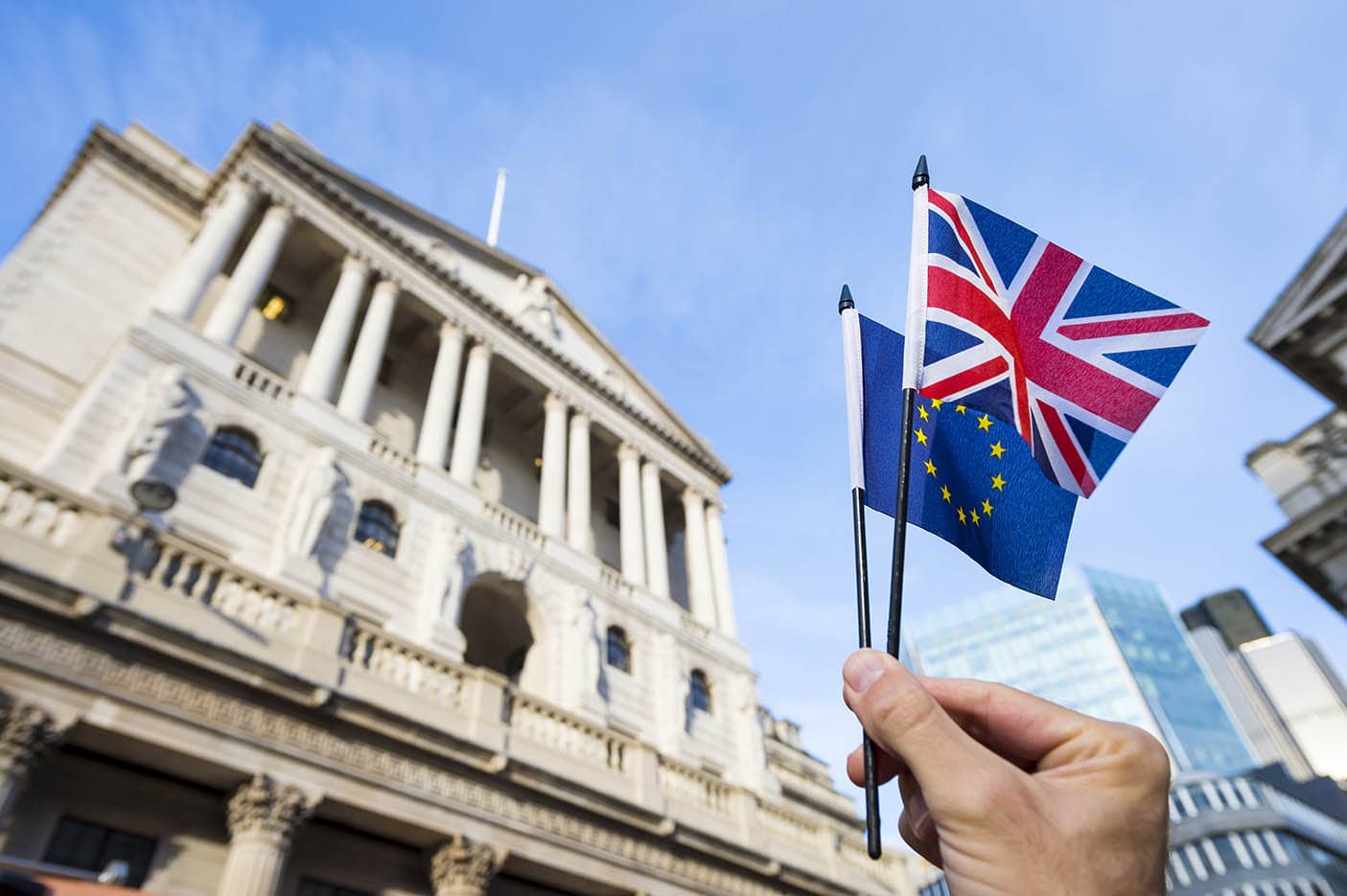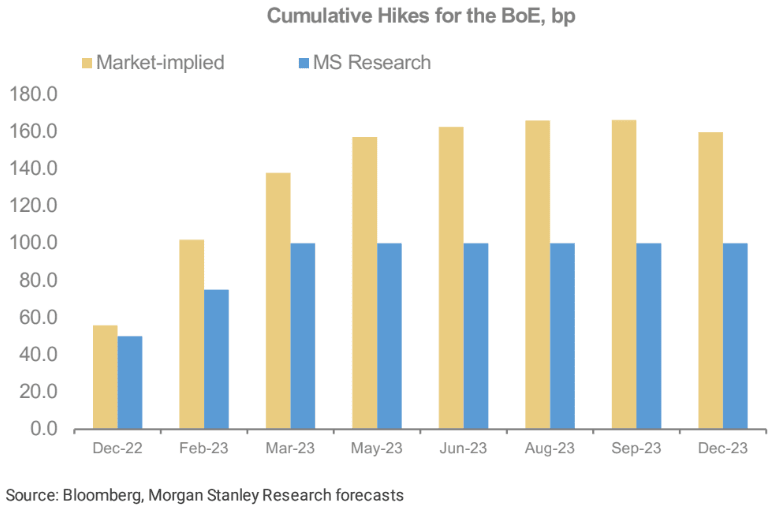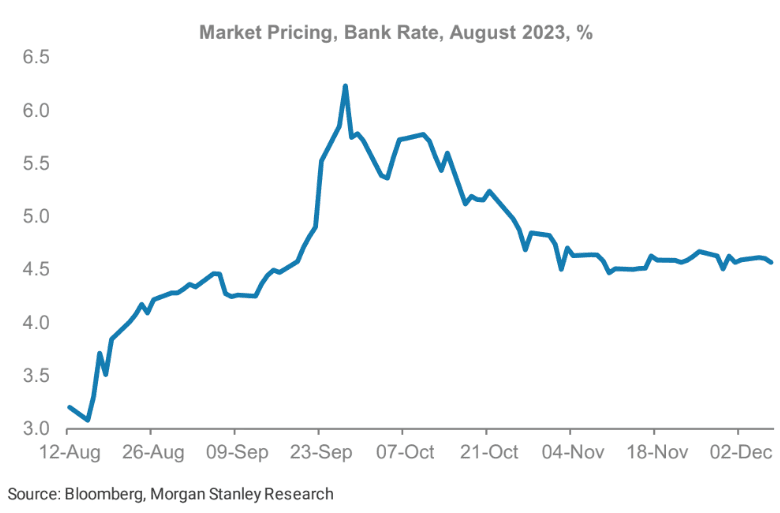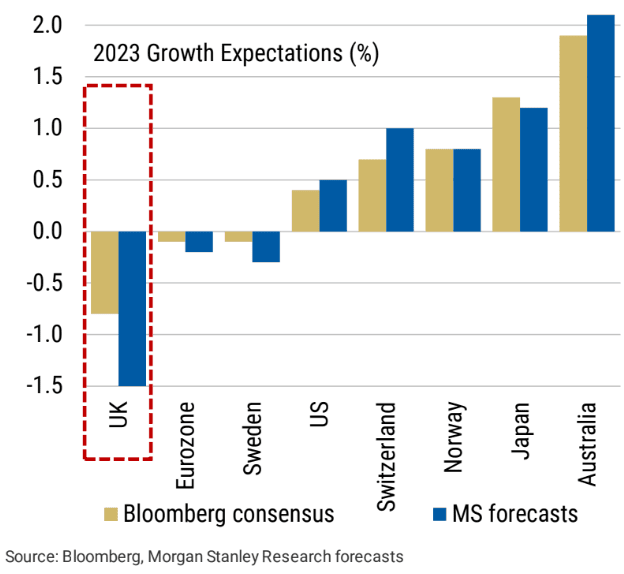Stay Cautious on Pound-Euro into Bank of England Decision says Morgan Stanley
- Written by: Gary Howes

Image © Adobe Stock
The British Pound could lose value to the Euro in the wake of Thursday's Bank of England interest rate decision and guidance, shows new research from Morgan Stanley.
The market consensus has the Bank hiking interest rates a further 50 basis points, although market pricing suggests another 75bp hike is not entirely out of the question.
Expectations for a 75bp move would have been bolstered by Tuesday's labour market data that showed UK wages continue to increase at inflation-boosting rates.
However, a rise in jobless claims, increased participation rates and falling vacancy levels argue for a 50bp move amidst signs the market is slackening.
Morgan Stanley is in the 50bp hike camp and holds a terminal forecast for Bank Rate at 4%, as they anticipate just two 25bp hikes in 2023, which is lower than the ~4.5% the market is currently pricing.
"In light of the pushback against market pricing in November, and the likely downshift in the pace of tightening by the Fed, we see the more hawkish members siding with the core of the Committee in voting for a 50bp move," says Bruna Skarica, UK and Scandinavian Economist at Morgan Stanley.
Strategists at the investment bank expect the decision to be, on balance, consistent with a fall in Sterling, with the Pound to Euro exchange rate (GBP/EUR) offering the clearest expression of these risks.
"We express GBP downside risks via long EUR/GBP," says Wanting Low, a strategist at Morgan Stanley in London, in the investment bank's preview of Thursday's event.
Compare Currency Exchange Rates
Find out how much you could save on your international transfer
Estimated saving compared to high street banks:
£25.00
Free • No obligation • Takes 2 minutes
The Pound fell briefly following the Bank of England's November policy update as the Monetary Policy Committee (MPC) communicated that the market's expectations for where Bank Rate would end this hiking cycle was set too high.
Analysts at Morgan Stanley say the Bank will try and push the market's expectations for the peak in Bank Rate lower, which will in turn put pressure on the yield paid by UK government bonds, particularly shorter-dated bonds.
The typical reaction function of falling central bank rate expectations and yields is a falling currency.
Above: Morgan Stanley is expecting fewer rate hikes ahead than the market.
The Bank of England said in August that rising interest rates would slow the economy into a multi-quarter recession and bring inflation to below its 2.0% target over the next three years.
Expect similar warnings on Thursday. "We expect lower front-end real yields as the BoE pushes terminal rate expectations lower," says Theologis Chapsalis, Head of UK Rates Strategy at Morgan Stanley.
Falling yields do however bring down borrowing costs across the economy and could therefore offer much-needed support to the growth outlook.
This observation leads currency strategists at NatWest to say the traditional linkage between currencies and interest rates could flip and falling rate expectations become supportive of Sterling.
"In fact, the pricing out of tightening would be a positive as it would further reduce fears of a housing market slump and raise hopes of a milder recession. A better inflation/demand profile would make other assets more attractive," says Paul Robson, Head of G10 FX Strategy at NatWest Markets.
The above chart shows Bank rate expectations have been falling since September, but the Pound has been rallying over this period, suggesting falling hike expectations could in fact be supportive of the currency.
Indeed, NatWest is constructive on the Pound against the Euro and Dollar for 2023.
The differing views on what a retreat in interest rate expectations mean for the Pound add an element of uncertainty to the December rate decision.
But the interest rate decision is one element of the day that will have significance for the Pound and investors will be looking beyond December.
Morgan Stanley looks for a 25bp hike in February and a final 25bp hike in March, which puts them on the more 'dovish' spectrum and they see upside risks to their core view.
"In the near term, we acknowledge the clear risk that the BoE delivers another 50bp move in February before stepping down to a 25bp pace from March," says Skarica.
Such an outcome could be supportive for the Pound if higher rate expectations translate into currency support.
Heading into year-end, Morgan Stanley is staying on the sidelines with regard to Pound Sterling given a lack of near-term UK-specific catalysts.
This opens the way for improving risk sentiment and the broad-based weakening of the USD to buoy the Pound-Dollar exchange rate.
But, "poor fundamentals should ultimately weigh on GBP, keeping GBP as a key laggard in 2023. We continue to recommend long EUR/GBP," says Low.
Compare Currency Exchange Rates
Find out how much you could save on your international transfer
Estimated saving compared to high street banks:
£25.00
Free • No obligation • Takes 2 minutes
Some Key Observations Made by Morgan Stanley:
"The short assessment of the past six weeks' worth of data is that the economy is broadly moving in the direction anticipated by the MPC at its early November meeting: the PMIs are weak, with new orders implying imminent reversal in activity."
"While the labour market remains tight, recruitment difficulties have eased and vacancies remain on a downward trajectory."
"A coordinated slowdown... the Fed is on course to deliver a 50bp move – as is the ECB, our euro area team thinks – and the dollar has likely peaked... the international context is also supportive of reverting to a 50bp hike."







